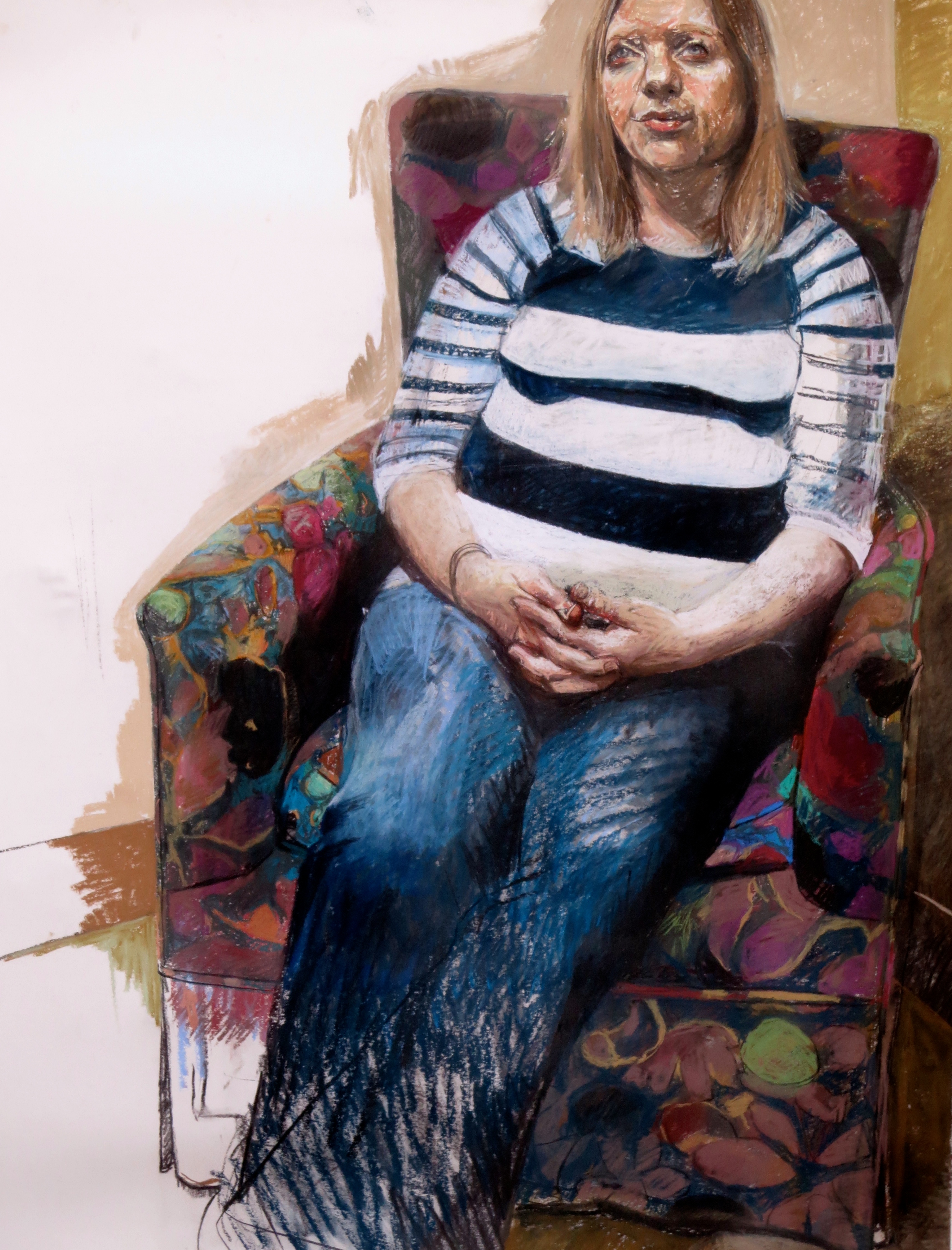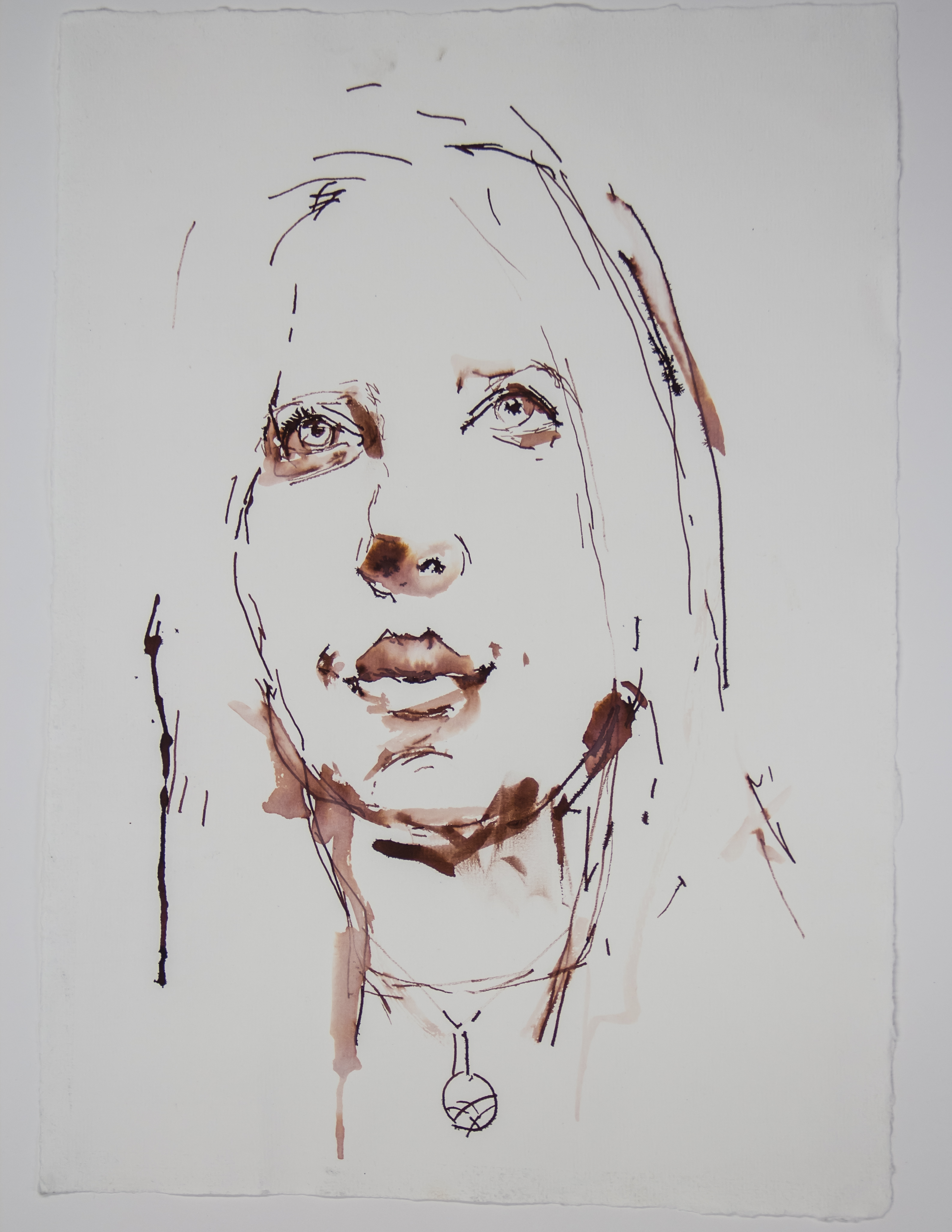Abstract
This article describes one collaborative arts-based research project. Portrait artist Mark Gilbert considers lessons for art and healing from one patient, Lisa. Lisa took comfort in the permanence of portraiture amidst the uncertainties of tongue cancer.
Arts-Based Research
The Experience of Portraiture in a Clinical Setting (EPICS) project sought to explore my artistic interactions and shared experiences with patients from the Head and Neck Cancer Clinic at the University of Nebraska Medical Center.1 The following portraits of Lisa enable investigation of the ethical and aesthetic value of permanence in Lisa’s illness and portraiture experiences.
Figure 1. Lisa, 2013

Courtesy of Mark Gilbert.
Media
Pastel on paper, 40" x 26".
Sit to Engage
Three years prior to sitting for her portrait, Lisa felt a small lump in the middle of her tongue. Six months later, a dentist urged her to see a specialist, and a biopsy confirmed cancer of the tongue. Pregnant, caring for a toddler, and working full time, Lisa felt that this diagnosis generated stress and uncertainty and even cast doubt on whether she and her husband should continue to expand their family. Despite feeling overwhelmed at times, Lisa agreed to sit for her portrait and be part of the EPICS study.
She welcomed the portraiture process as an opportunity to reflect on her illness and its influence on her family, especially her relationship with her husband. An important part of her portraiture experience was witnessing the development of other head and neck patients’ portraits as she sat for her own portraits. For Lisa, this experience illuminated other subjects’ resilience and brought about an evolution in her perspective of what was happening to her and her family: “Others had it worse,” she remarked. When discussing other participants’ portraits, she marveled at how they were all so different, despite each participant sharing similar experiences of enduring cancer and its treatment.
Portrait Making as Story Building
Portraiture in a clinical setting can create opportunities for subjects to build a narrative of self; at the same time, it can be a catalyst for sharing subjects’ stories with others.2 These two ethically and clinically relevant themes illuminate important dimensions of EPICS study patients’ experiences. An important role of the portrait artist, then, is to enable emergence of new perspectives for the patient by generating new ways of thinking for the viewer.
Prior to painting in health care settings, my view of portraiture was traditional: portraits depict an individual and, more often than not, a great and good individual. Portraits hang in museums, separate from our everyday lives. My deep dissatisfaction with this narrow conception of what a portrait is was fueled partly by the richness of the relationships I developed with patients who sat for me. After witnessing how sitters found value in their portraits and in the process of making them with me, I discovered how portraiture could foster a relational aesthetic3 that was compassionate and healing, “inclusive rather than elitist,”4 and based on an ethics of care.
As Lisa sat with her experiences, time and our connection folded them into her portrait.
Once treatment is over, some patients find it challenging to create and sustain their own healing. Spiritual, intellectual, physical, and emotional healing is deeply personal, ever evolving, and continues even when interventions and drugs stop. When participants enter the studio space where I paint, they are invited to sit in an empty chair, a kind of blank slate, where they can initiate conversation with me, sit silently, or both. Over time, we typically navigate ways to weave past, present, and future experiences into an aesthetic whole to create and give shape to a story and portrait. For Lisa, sitting gave her an opportunity to engage with her own healing journey and to communicate and connect with others.
Figure 2. Lisa, 2013

Courtesy of Mark Gilbert.
Media
Pen and ink, 17" x 12".
Put on Hold
At our first meeting, I began working on quick pen and ink studies. Lisa described how insensitively she felt the news of her initial cancer diagnosis was given to her. She looked back with some amusement on how she perceived her clinicians as scrambling for an explanation of her cancer. She often found humor in episodes that were anything but humorous at the time. For example, Lisa went through multiple tests for other causes of her symptoms and other possible diseases, including syphilis, that might explain them. “I could have done without that [test],” she said wryly. The cause of her cancer remained a mystery.
I always met Lisa at 8 o’clock in the morning. I greeted her in the same waiting room where her surgeon met her. My studio was in the Head and Neck Cancer Clinic, a tiny windowless postal room containing only an easel and a chair. Since portraiture took place where patients came for clinic visits, this arrangement tended to encourage comparisons between patients’ experiences of waiting in the clinic for portrait making and waiting in the clinic for appointments with clinicians. For Lisa, her attitude and approach to the portraiture process was a counterpoint to medical visits to the clinic. She contrasted feeling comfortable during portrait sessions with feeling anxious in the face of persistent scanning for clinical problems.
During her studio sittings, Lisa expressed how her diagnosis and treatment had put her and her husband’s lives “on hold.” However, at the time of her participation in the EPICS study, she celebrated herthird year of being cancer free. She was optimistic, looking forward to a forthcoming holiday and to the birth of her second child and delighted that the portrait would depict her at this time in her life. Her pregnancy kept her awake at night, and she jokingly requested that I leave out the dark rings under her eyes. She recognized the potential for the portrait to visually draw focus to her pregnancy, to the imminent birth of her child, while simultaneously enabling reflection on her recovery from tongue cancer.
Lisa said she felt “honored” to have been asked to participate in the study.5 Overall, she found the process deeply reflective. She described sitting for a drawing as an opportunity to reminisce, contemplate, and sit quietly. She explained: “there were some empty moments” that were “a great break! to just sit here and be still…. It was still kind of refreshing.” Lisa said that quieter times like this enabled her to “contemplate where I’d been and what the future may have.” For Lisa, the tincture of time had been healing. As Lisa sat with her experiences, time and our connection folded them into her portrait. She noted that her identity was transformed, that she became stronger.
Finding Permanence
Lisa acknowledged how sitting for her portrait—and the portraits themselves—enabled her to prepare for dialogue with others that might not have otherwise occurred. Although she had addressed her illness and recovery process with family, friends, and coworkers, prior to participating in the EPICS study, she had not been given the time and space to share her whole story in free form. Lisa explained that she “loved” sharing pictures of her portraits because “it opened up discussion about how far I’ve come” and added that now “they know what I went through.” It enabled her to share her medical journey and reflect on how her personal growth had changed her from who she was two-and-a-half years ago.
Lisa was an active participant in the portraiture process. As she sat, she saw finished and unfinished portraits of other cancer patients and survivors on the walls and easels around her and felt camaraderie with those patients and with me. Lisa often asked about the other subjects I’d painted and about how their feelings about their own portraits had changed over the course of my painting them. She considered, analyzed, and remarked on the progression of portraits of others with whom she sat in fellowship, as she shared with them a kind of collective experience of being a patient and of being painted as a member of that community of patients. Lisa described this community as having a collective story as head and neck cancer clinic patients: “We all overcame something…. Everyone kind of has that look that ‘I did it … I did overcome that!’” Lisa welcomed the fact that her portrait could serve as a medium by which viewers might better understand and interpret lived experiences of cancer. Sharing her own lived experiences seemed particularly valuable to Lisa, as she felt “proud” to have the portraits displayed.
For Lisa, participation in the EPICS study offered a kind of permanence in portraiture. That is, her portrait could serve as a testament to her children of their mother’s life: “This is something that will be around, for hopefully for a very long time, and it is kind of neat like it captures this moment in my life.” Moreover, she realized the portraits’ potential to spread the message that she was not only a cancer survivor, but also a thriving, lively, active individual. Lisa pointed out that she was “strong for making it through” her cancer journey and affirmed, “If I can get through this, I can, you know, get through anything.” Lisa said, “Looking back … I do think really positive about what we went through and I feel positive about the future.”
References
- Gilbert MA, Lydiatt WM, Aita VA, Robbins RE, McNeilly DM, Desmarais MM. Portrait of a process: arts-based research in a head and neck cancer clinic. Med Humanit. 2016;42(1):57-62.
- Gilbert MA. Experience of portraiture in a clinical setting: an artist’s story. J Appl Arts Health. 2014;5(1):135-150.
-
Bourriaud N. Relational Aesthetics. Dijon, France: Les Presse Du Reel; 2002.
-
Moon CH. Studio Art Therapy: Cultivating the Artist Identity in the Art Therapist. London, UK: Jessica Kingsley; 2002.



